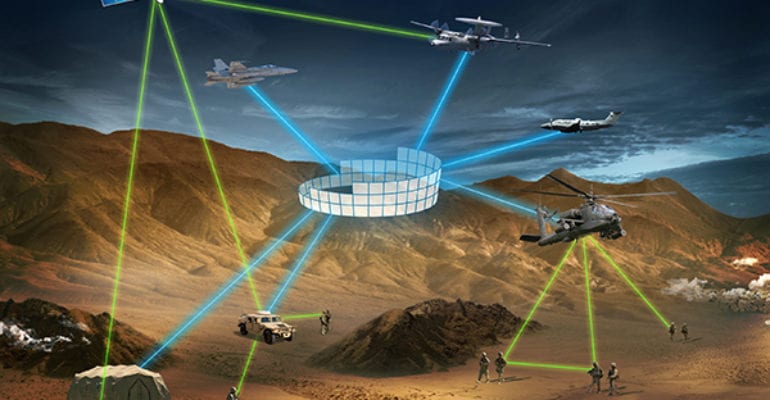Latest News

Viasat Link 16 network visualization. Photo: Viasat
Viasat is selling its Link 16 Tactical Data Links (TDL) business to L3Harris Technologies in a nearly $2 billion divestiture that the companies say sharpens Viasat’s core focus and deepens L3Harris’ focus in Joint All-Domain Command and Control (JADC2) solutions.
The TDL network, or Link 16 network, is integrated on military aircraft, ground vehicles, surface vessels and operating bases, and securely transmits voice and data communications. L3Harris will acquire the TDL product line including Link 16 Multifunctional Information Distribution System (MIDS) platforms and associated terminals, which are installed in more than 20,000 aircraft, ships, and ground platforms globally.
The TDL product line is currently part of Viasat’s Government Systems segment and generates approximately $400 million in annual sales. The acquisition includes about 450 employees. The companies expect the deal to close in the first half of 2023, subject to regulatory approval. The sale is expected to result in cash proceeds to Viasat of approximately $1.8 billion net after taxes, fees, and expenses.
L3Harris said this acquisition provides access to Link 16 waveform, platforms, and prime contracts. It will allow the company to “expand resilient communication and networking capabilities to a larger user base, achieving broader end-to-end, sensor-to-shooter connectivity – from operators to platforms or weapons data links and beyond – across multiple domains,” L3Harris said in a press release.
“This acquisition is part of our strategic effort to ensure operators have access to the most advanced, multi-function Joint All-Domain Command and Control solutions available,” Christopher Kubasik, L3Harris CEO and chair said. “Viasat’s TDL product line naturally aligns with our proven communication capabilities, and we are excited to partner with our customers and coalition allies as we modernize the Link 16 enterprise.”
L3Harris is a JADC2 prime contractor and is one of five companies the Air Force selected to be a part of the Advanced Battle Management System Digital Infrastructure Consortium to design and develop the JADC2 digital backbone for the Department of the Air Force.
This divestiture comes as Viasat is in the process of acquiring global satellite operator Inmarsat. Viasat said proceeds will pay down debt and align the company’s focus with its core strategy of building a service platform for mobility and fixed markets.
“TDL has been a fantastic business for us. … We’re proud of the impact that Link 16 has had in supporting U.S. national security, and that of our global allies,” CEO Mark Dankberg said in a blog post about the transaction. “But continued defense consolidation, and a rapidly evolving tactical network environment, deserve more ongoing investment in terrestrial data links than we can support.”
The Link 16 TDL business accounts for about 35% of Viasat’s Government Systems revenue. In the 2022 fiscal year, Satellite Services surpassed Government Systems as the largest revenue driver for the company. The segment reported $1.087 billion in revenue in 2022, compared to $1.066 billion in 2021. Viasat said this segment has been “treading water” due to effects of the pandemic, while Satellite Services saw record growth in-flight connectivity services, growth from the RigNet and EBI acquisitions, and growth in fixed broadband.
Post-transaction, the segment will focus on satcom-as-a-service with secure, multi-network satellite services, zero-trust cybersecurity services, information assurance, and space networks for data relay. Dankberg said post-sale, Government Systems annual revenue will be approximately $700 million. Then after the Inmarsat transaction, Viasat anticipates it to be more than $1 billion annually. Proceeds from the sale are expected to reduce the combined Viasat and Inmarsat net leverage following the closing of the Inmarsat acquisition by approximately 0.7 of a turn by June 30, 2023. Viasat expects proceeds to fully fund a path to positive free cash flow.
Dankberg said that after the Link 16 TDL and Inmarsat transactions are complete, Viasat expects approximately 77% of corporate-wide revenue to be from recurring services.
“While we’ve been most focused on broadband, Inmarsat’s extensive spectrum holdings and L-band satellite fleet also open exciting growth opportunities in narrow band satellite services, and especially in the rapidly emerging satellite direct-to-mobile handset market,” Dankberg said. “The recent partnership between Apple and Globalstar is indicative of the compelling potential of that area – that we believe can benefit from many of the same technology innovations underpinning ViaSat-3.”
Get the latest Via Satellite news!
Subscribe Now